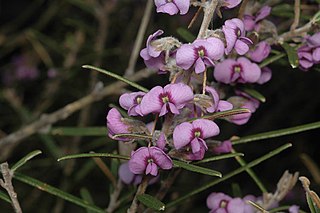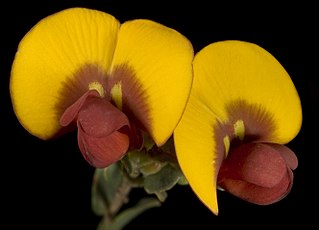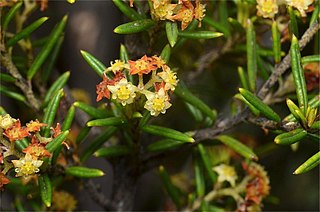
Hovea linearis is a species of flowering plant in the family Fabaceae and is endemic to eastern Australia. It is an erect or trailing subshrub with mostly narrowly linear to linear leaves with stipules at the base, and mauve and yellowish-green, pea-like flowers.

Hovea rosmarinifolia, commonly known as mountain beauty or rosemary hovea is a shrub in the family Fabaceae, native to Australia. A small shrub bearing attractive blue-purple or mauve pea flowers from August to November.

Pultenaea dargilensis is a species of flowering plant in the family Fabaceae and is endemic to a small area in central Victoria, Australia. It is a leaning or low-lying shrub with narrow elliptic to lance-shaped leaves and yellow flowers usually arranged singly on the ends of branchlets.
Bossiaea alpina is a species of flowering plant in the family Fabaceae and is endemic to a small area in south-eastern Victoria, Australia. It is a diffuse shrub with oblong to elliptic leaves and bright yellow flowers arranged singly on the ends of branchlets.

Pultenaea luehmannii, commonly known as thready bush-pea, is a species of flowering plant in the family Fabaceae and is endemic to the Grampians National Park. It is a diffuse, more or less prostrate sub-shrub with trailing branches, narrow elliptic leaves, and orange and dark brown flowers.

Bossiaea pulchella is a species of flowering plant in the family Fabaceae and is endemic to the south-west of Western Australia. It is a slender, erect shrub with egg-shaped leaves, and orange-yellow, purplish brown and dark red flowers.
Bossiaea spinescens is a species of flowering plant in the family Fabaceae and is endemic to the south-west of Western Australia. It is a slender, spreading or compact, spiny shrub with oblong to oval leaves and yellow and reddish-brown, pea-like flowers.
Pultenaea vestita, commonly known as feather bush-pea, is a species of flowering plant in the family Fabaceae and is endemic to south-western continental Australia. It is an erect to prostrate, sometimes mat-forming shrub with elliptic to linear or lance-shaped leaves, and yellow and red, pea-like flowers.

Hovea apiculata, is a species of flowering plant in the family Fabaceae and is endemic to eastern Australia. It is a shrub with white to greyish or light brown hairs, narrowly oblong leaves with stipules at the base, and purplish and deep mauve, pea-like flowers.
Hovea arnhemica, is a species of flowering plant in the family Fabaceae and is endemic to the Top End of the Northern Territory. It is a subshrub with light brown hairs, narrowly egg-shaped or elliptic leaves with stipules at the base, and mostly white, pea-like flowers.

Hovea asperifolia is a species of flowering plant in the family Fabaceae and is endemic to south-eastern continental Australia. It is a shrub with hairy branchlets, narrowly oblong to narrowly linear leaves with stipules at the base, and mauve, pea-like flowers.
Hovea cymbiformis is a species of flowering plant in the family Fabaceae and is endemic to New South Wales. It is a shrub with foliage covered with brownish to grey hairs, narrowly elliptic leaves with stipules at the base, and mauve and yellowish-green, pea-like flowers.
Pomaderris virgata, commonly known as upright pomaderris, is a species of flowering plant in the family Rhamnaceae and is endemic to south-eastern continental Australia. It is an erect, slender shrub with hairy branchlets, lance-shaped, narrowly elliptic or oblong leaves, and dense panicles of golden-yellow flowers.
Sphaerolobium acanthos, commonly known as Grampians globe-pea, is a species of flowering plant in the family Fabaceae and is endemic to a restricted part of the Grampians National Park in Victoria. It is an erect, wiry shrub with many spiny branchlets, scattered tapering leaves, and yellow, orange or reddish-brown flowers.
Spyridium coalitum is a species of flowering plant in the family Rhamnaceae and is endemic to Kangaroo Island in South Australia. It is a slender, erect shrub with softly-hairy young stems, oblong to narrowly elliptic leaves, and head of white to cream-coloured flowers.
Hovea pedunculata, is a species of flowering plant in the family Fabaceae. It is an small shrub with mauve flowers, dark green leaves and rusty coloured new growth. It grows in Queensland and New South Wales.

Spyridium daltonii is a species of flowering plant in the family Rhamnaceae and is endemic to Victoria in Australia. It is a shrub with softly-hairy branchlets, linear to narrowly elliptic leaves, and small groups of hairy, yellowish flowers.

Hovea graniticola is a species of flowering plant in the family Fabaceae and is endemic to eastern Australia. It is a shrub with its branchlets covered with curly brownish to grey hairs, narrowly oblong to almost linear leaves with stipules at the base, and mauve, pea-like flowers.
Hovea magnibractea, is a species of flowering plant in the family Fabaceae and is endemic to south-eastern Australia. It is a shrub with narrowly oblong to lorate (strap-shaped) leaves, and mauve and yellow, pea-like flowers.

Hovea similis is a species of flowering plant in the family Fabaceae and grows in New South Wales and Queensland. It is a shrub or small tree with hairy foliage and mauve and yellowish-green pea-like flowers.









